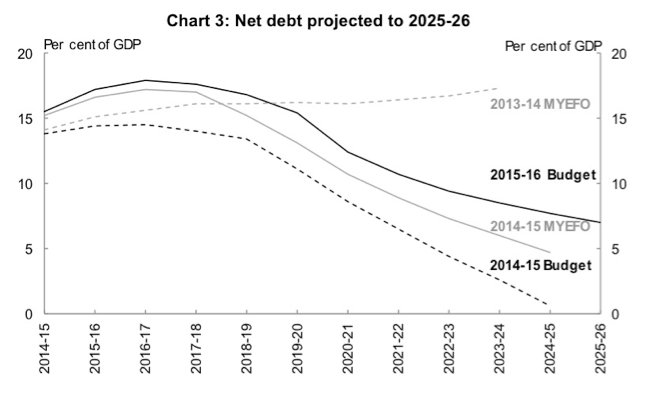Budget 2015: A clash of narratives
Was the “debt and deficit crisis” of 2014/15 exaggerated, or has “budget repair” just become too difficult?
Last year’s Commonwealth Government budget was an absolute shocker for Treasurer Joe Hockey. Riddled with punitive measures, it was widely condemned from all quarters before the Senate slowly rejected most of the harsh measures contained within it. Consequently the government’s popularity plummeted and the pressure even resulted in leadership tensions.
Last year, the government’s justification for the harsh measures was that Australia was suffering a “budget emergency“:
But thanks to Labor’s poor management over five years, there is now a budget emergency.
Tony Abbott, 16 May 2013
The justification was that Australia’s debt-to-GDP ratio was too high and more importantly, unsustainable. Hence the nation could no longer afford to offer bulk billing to all, support the unemployed, subsidise university education or pay the pension amongst other measures.
How times have changed.
In last night’s budget speech, the tone had completely differed. Clearly the government adopted a realpolitik approach following the raft of legislative blocks in the Senate and presented the promised “dull budget“. No more savage cuts, no more punitive cuts to programmes. Instead, the narrative is all about “opportunity”.
To achieve this, the budget’s forecasts for a return to surplus have been pushed out a year. Surplus was initially projected to be achieved in 2018/19 but is now projected for 2019/20. This assumes that Australia does not fall into recession between now and then and returns to trend growth in the next 18 months. It’s risky, but possible. The budget still contains many cuts to expenditure, but not of the magnitude seen in the 2014/15 budget.

Oddly, whilst the government was largely unsuccessful in implementing its harsh budget cuts in 2014/15 due to the community backlash and Senate hostility the crisis is now apparently over.
I never supported the government’s nasty budget measures, but I am also alarmed at the absence of principle that seems to have imbued this budget. The 2015/16 budget gives the distinct impression that the coveted “budget repair” that the government spoke of just became a bit too difficult and they’ve now given up. Whilst I always rejected the “budget emergency” story, I do accept that there needs to be a plan to return to surplus.
When former Prime Minister Kevin Rudd spoke of climate change being “the greatest moral challenge of our times” and then abandoned his plan to introduce an emissions trading scheme, people rightly derided him for being being unprincipled. Joe Hockey and Tony Abbott spoke of the “debt and deficit crisis” and “budget emergency” and have now handed-down a budget that seriously delays addressing these key concerns (let alone does anything to substantially increase revenue which is the government’s fundamental problem).
Treasurer hockey may temporarily win over sections of the community that were spooked by his previous budget, but his government now risks the same fate as Kevin Rudd’s. Whether the government was exaggerating the crisis before or have given up on it now, the clash of narratives seriously brings their credibility into question.
Comments
No comments have yet been submitted. Be the first!